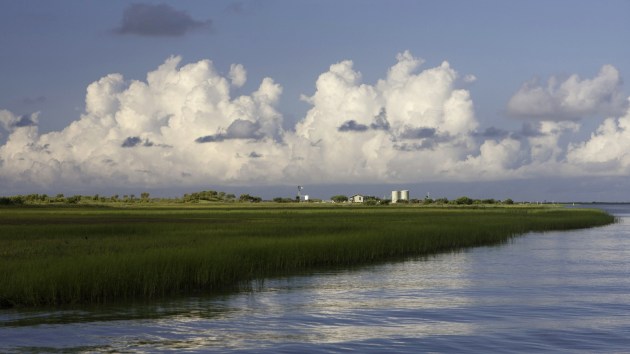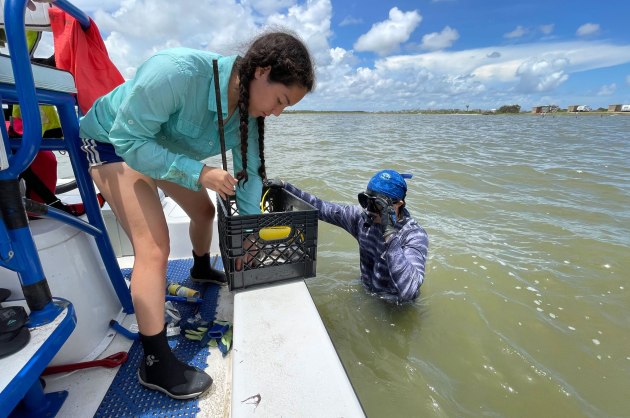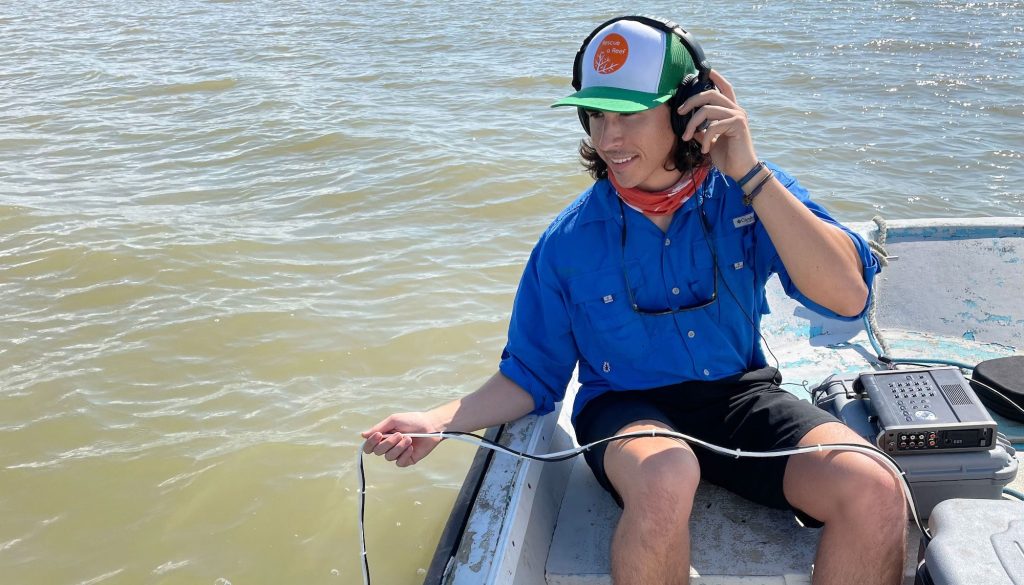Philip Souza is eavesdropping on oyster reefs. The University of Texas Marine Science Institute PhD candidate is part of a team at Mission-Aransas National Estuarine Research Reserve studying the sounds of oyster reefs on the Texas Gulf Coast. The state’s oyster reefs were once extensive, offering some measure of protection against shoreline erosion and providing habitat for numerous animals. But overharvesting and other factors has left reefs only a fragment of what they once were.
The marine science institute’s research, which uses a technique called passive acoustic monitoring, is examining what an oyster reef sounds like and if, perhaps, its sounds can tell us something about its health.
- How did you end up in acoustic monitoring?
-
When I came here, I put out some recorders in the field, just to sort of see what I would get in the underwater recordings. I was blown away by all the sounds that I was hearing in the estuary. I thought, surely, there’s a lot that we can learn from these underwater sounds about the health and condition, the functioning of the communities in the estuary, just by listening.
- What does that estuary look and sound like?
-
The Mission-Aransas Estuary is my study system. It’s made up of mainly, two bays, Copano Bay and Aransas Bay. It’s a great system to use passive acoustics because it’s very murky. You might hop into the estuary with a snorkel mask and you can maybe see a few inches in front of your face on a good day. So any type of visual survey is not very practical.
There’s also a ton of sound production going on. We have a lot of what are called “drum and croaker” species. These are fishes that belong to the family sciaenidae, and they produce sound primarily for courtship and spawning. When they’re really going and spawning they have this behavior that’s called “chorusing” where they form a big aggregation and they all vocalize together and it creates this really dramatic acoustic signal. When you hear that, it’s a really good indication that they’re spawning in the area.

Aransas Bay is home to Mission-Aransas National Estuarine Research Reserve. Together with its extensions—including Copano Bay, where The Nature Conservancy has worked to restore two oyster reefs, and Redfish Bay, seen above—the bay system is one of the seven major estuaries along the Texas Gulf Coast. © Erika Nortemann / TNC - You’ve got some oyster reefs in the estuary as well, right?
-
There’s a lot of historically very healthy oyster reef in our estuary, and it’s a very rich acoustic environment. In past decades, these reefs have been very healthy and productive. There were folks making a lot of money off them as a fisheries resource. But in recent decades, they’ve been degraded for a number of reasons: harvest pressure, increased disease, climate change has played a role, as well as pollution in the area.
But [in response] there’s been a big outcry and effort to preserve the oyster reefs. People have been trying to ramp up the monitoring efforts on these oyster reefs and trying to restore some as well. The Nature Conservancy has installed a big, restored reef in Copano Bay.
- So, you've got this acoustically rich area to do your work. What research question did you first set out to answer?
-
One of the first questions that I was interested in was comparing the communities that were settling on these reefs, to what we were hearing in the soundscapes.
So, one of the first projects that I did was “paired sampling.” We started that project in July of 2021. We put out what we call oyster sampling trays, which are milk crates that are lined about a third of the way up with fine mesh, mosquito netting. You put reclaimed oyster shells into the baskets, and then you set them out on the reefs for four to six weeks. Then you pick up these trays and look at the animals that have settled in these trays to get an idea of what the communities look like.
In this soundscape, recorded at dusk at Goose Island State Park, snapping shrimp, Gulf toadfish, silver perch and spotted seatrout can be heard. © Philip Souza - So you said “paired sampling.” What was this paired with?
-
Acoustic sampling. We wanted to compare the soundscapes that we were seeing on these newly restored reefs—the development of that soundscape—with the development of the community [we saw in the sampling trays]. For example, are these reefs louder when there are more animals on those reefs? Because if you find these relationships, then you can use those relationships to monitor the structure of the community through time.
- So you're sort of ground truthing the idea of acoustic monitoring as a viable way of measuring the biodiversity?
-
That’s exactly right. And that was another relationship that we were interested in looking at: Does diversity of sounds translate to diversity of species that we’re getting in the oyster trays?
- What types of organisms are we talking about here on the reefs?
-
So, two of the more common [sound-producing] animals are Gulf toadfish and snapping shrimp. But we also see a lot of species that are not known to produce sound as well, for example, a speckled worm eel, a skilletfish. And then, every once in a while, we’ll get a more mobile fish species, like a mangrove snapper.

Gulf toadfish (Opsanus beta) are common oyster reef inhabitants in the Mission-Aransas Estuary. Their “boat whistle” sounds in the spring and early summer are part of the local oyster reef soundscape. © Christina Marconi - What do these creatures sound like?
-
They oftentimes sound very different [from each other]. That’s really helpful for my purposes, because you can put one of these underwater recorders in the estuary, you can listen to these unique sounds, and you can get an idea of what fish are in the area, and also what they’re doing at that time.
My favorite is the Gulf toadfish, which is this adorable little fish and to me, it sounds a little bit like a really cute horn. Another very common one that we hear is this snapping shrimp. It makes a popping sound. Typically, you have what sounds like thousands of them at the same time, and it sounds almost like Rice Krispies cereal: When you pour the milk over it, you’ve got that snap, crackle and pop.
Then, depending on the season and time of day, you will also hear some more transient species. So there [might be] a hardhead catfish. To me, it sounds like drip coffee that’s being made in the morning.
- What have you learned from the paired sampling so far?
-
Well we have some good preliminary results. The biggest surprise was how responsive the soundscapes were to natural disturbances. In 2021, we had a big freshwater inflow that reduced the salinity very quickly and very dramatically, and during that period we saw a very steep decline in the sound levels on those oyster reefs.
We’ve also seen very strong responses in the soundscape to restoration efforts. If you put a recorder on a newly restored oyster reef, you see the sound levels increase through time as that reef is being settled by different organisms.

Philip Souza (in the water) and Mona Birgisson prepare an oyster box for deployment near Goose Island State Park at the mouth of Copano Bay. Oyster boxes are used to study the dynamics of oyster reef fish and invertebrate communities. © Christina Marconi - What’s next for the project?
-
Our lab just got a big grant to study health and functioning of oyster reefs in South Texas, and a component of that research is going to be acoustic research on those reefs. I think that the results from that study will be a little bit more telling: If we get some really strong relationships during that study, then that’ll really solidify that [hypothesis].
One other thing that I’m really interested in too though is oyster soundscape playback: A researcher by the name of Ashlee Liliss did a lot of really cool research in North Carolina to show that oyster playback actually attracts larval oysters to the sites. So there’s this idea that’s been floated around that if you have a broken soundscape in an area due to either high fishing pressure or some sort of disturbance that you can play healthy reef soundscape sounds and that’ll attract larval oysters to that site. And that site will build up quicker.
- Wow! How does that work? What’s the mechanism that people think is drawing them to the sounds of the reef?
-
The thought behind this is that oyster reefs have very distinct soundscapes: Because you have more of these toadfish and snapping shrimp, the soundscapes are usually louder and more complex than, say, a surrounding mud-bottom habitat. So, if you’re a larval oyster that’s floating around in the water column, it might be pretty quiet. And then all of a sudden, you get this really big increase in sound production. That might be a settlement cue for you, because that suggests that there’s hard-bottom habitat that these animals might be using that you can settle on.
- That’s fascinating. So that’s something you’re hoping to look into more with this upcoming project?
-
Yes, the first step with that will be to better understand what it means to have a healthy soundscape and understanding the characteristics they have: Is it higher sound levels in a given frequency band? Is it more snapping shrimp snaps in that area? Is there an acoustic cue that we can home in on that says this site is healthy and productive? And then once we have that, hopefully coming up with a tool where we can get oyster condition from the soundscape and then identify areas that might benefit from playback in that area.




Join the Discussion